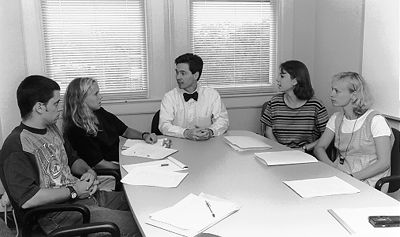
Dr. Terence Dermody (center) and Vanderbilt medical and graduate students (from left) Peter Eby, Suzy Humphreys, Michelle Grundy and Michele Spring are developing a course to bring AIDS information to area high schools
Students create course to bring AIDS education to region's high schools
A group of Vanderbilt medical and graduate students recently set out to create a situation that would accomplish two goals: help them hone their teaching skills while at the same time informing teenagers about the AIDS virus and how it can impact their lives.
Medical students Peter Eby, Suzy Humphreys, Chris Petit and Michele Spring and graduate students Erik Barton and Michelle Grundy have spent a great deal of time this summer creating a course that would allow them to achieve these goals.
With the guidance of Dr. Terence S. Dermody, assistant professor of Pediatrics, the students have built a course that includes not only the lectures by education professors on how to teach but also a four-session class to be taught by students at area high schools.
"Incorporating a didactic educational system for our students to learn effective teaching techniques is new," said Dermody. "The tradition of our students going out into the community and doing wonderful things is very old. This is just another example of what Vanderbilt University Medical Center does best."
The first segment of the course is a four-week in-service training in interactive teaching techniques, sponsored by the Peabody School of Graduate Education. This session is meant to prepare the students to face the rigors of the high school setting and to allow them to think of new ideas about how to convey their messages.
The second segment is four weekly sessions in classrooms at area high schools, led by teams of four to five medical and graduate students. Each of the classroom sessions focus on different aspects of the subject of HIV and AIDS.
The first session will attempt to put the teenagers at ease by building a mentoring relationship with the graduate and medical students.
"Many people in the community regard Vanderbilt as a place you read about in the newspaper, but they can't see themselves as a student there. Our students are people that the teenagers can connect with and yet they are graduate students and medical students. Hopefully, getting to know our students will help them conceptualize themselves in that role," says Dermody.
VMS II Peter Eby says, "The use of young people as role models is key in this project."
The second session of the classroom experience helps the teenagers learn about the biology of HIV/AIDS. Instead of simply listening to lectures, the students will participate in activities designed to show the dangers of the virus.
"We are trying to avoid the lecturing approach and include more active learning. We want to be more interactive in these sessions," said Michelle Grundy, a fourth-year graduate student.
In the third session the students will explore how decisions can impact their lives by role-playing various situations and then discussing the choices they made.
"I would like them to take away something personal from our visits," VMS II Michele Spring said. "We talk a lot about the biological aspect of HIV/AIDS but I would like to see them learn the prevention side of things and incorporate that into their lives."
In the last session an HIV-positive individual will come to visit with the class.
"I think it is important that we bring in an HIV-infected person so that the students can see that this is not some rare disease. They will be able to see it up close and understand," says VMS II Susy Humphreys.
The group of Vanderbilt students also has an idea for bringing the program to the Internet. Because most high schools now have opportunities for teens to access the Internet, Dermody wishes to place a page on the Vanderbilt World Wide Web site for students to ask follow-up questions and comment on the effectiveness of the program.
"We also hope that our program will be emulated by other institutions," Dermody said. "Providing a web page is our way of helping that process.
"Having a medical school in a community is a great privilege for that community and for the students who train there. The community is our partner. We have responsibilities to them and they have responsibilities to us. We should foster that kind of relationship everywhere," he said.













